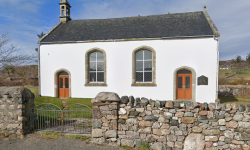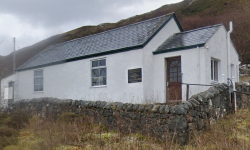Thomas Fraser of Kinlochbervie
Rev Robert Clark stayed in the Established church at the Disruption. Therefore there was no incumbent to become the first Free Church Minister as was the case in Durness and Scourie. Thomas Fraser was first minister of the Kinlochbervie Free Church, ordained in 1848. He was born in 1814 at Redcastle on the Black Isle. He studied at the Aberdeen Divinity Hall, and New College, Edinburgh. He married Mary Innes Sinclair of Melvich and they had a son and two daughters. There is no proper obituary of him but the congregation erected a Memorial in the Oldshore cemetery, which reads:
In Memoriam
OF THE
Revd. THOMAS FRASER,
Minister of the Free Church, Kinlochbervie,
Who died 18th September, 1862,
In the 46th year of his age, and in the 14th of his ministry.
This stone is placed here by his sorrowing congregation to mark their profound attachment to him as a pastor, and their high value of his unwearied exertions to promote their temporal and spiritual interests during the period of his ministry among them.
Rev Alexander Macrae wrote of the period:
The opposition of the Duke of Sutherland to the Free Church and his refusal to grant sites had the effect of delaying the settlement of ministers, for they had no church to worship in and no manse to live in. The years immediately after forty-three were years of almost incredible hardship and suffering for both ministers and people. The case of Kinlochbervie was peculiarly difficult. At first they had no place to meet in except on the public highway under Craig na Speireig. The elders who resigned after Mr. Clark’s intrusion were not willing to accept office again. They were all keenly interested in the work of the church, but their past experience made them hesitate. Eventually in 1846 four were appointed, namely, Angus Calder and John MacKenzie, Achrisgill; John Macleod, Oldshoremore; and Donald Morrison, Sheigira. They were the first Free Church elders in the parish. Mr. Eric Findlater has left a pen portrait of one of them in the Annals of the Disruption. “He had what you could conceive as being the look of Ezekiel. He was a tall dark complexioned man, with a countenance as if cast in bronze, a sharp black eye, deeply set in the head, and surmounted by shaggy eyebrows. His hair was long and dark brown, and he wore a great coat made of homespun cloth. His look was downcast, and his voice deep, but not harsh . . . You felt that before you stood one who had deep experience in the Christian warfare.” This was Angus Calder.
The people were poor, and at that period suffering the utmost privation through the failure of the potato crop. Many were at the point of starvation, yet the collectors who formed the Association for the Sustentation Fund were able to guarantee a sufficient amount to enable them to call a minister. In 1848 they called the Rev. Thomas Fraser, who had been supplying the pulpit for some months. The hearts of the parish as one went out to him, and he accepted their call.
No sooner was the Duke shamed to grant sites than building began. The new church was finished in 1846, but when Mr. Fraser was called there was no manse nor any immediate prospect of getting one. He gladly accepted the call of a people who gave him their hearts though they could not give him a home to live in. In spite of their poverty they were happy together. The parish minister was well housed, state paid, but soul starved, while he was homeless, often hungry, but very happy. While they had no money to give for the erection of either church or manse they had great goodwill which in the form of free labour became the equivalent of a large sum of money. Early in 1851 the manse was finished. It was the gift of the Manse Building Fund of the Church. When it was finished it cost about ₤50 more than the original estimate, and the contractor refused to hand over the key till that sum was paid. George Corbet, who acted as congregational treasurer, wrote to the Manse Building Committee, and the ₤50 came, which turned the key in the door, and let the waiting minister inside.
There is no tradition of the house warming, but obviously he did not find it as home-like as he wished. There was a young lady in Melvich, Mary Innes Sinclair, who had agreed to come to help him to make the manse a home. They were married in 1855, but their happiness was short lived. She died, leaving two daughters, one of whom is Mrs Macintosh, Melvich. It is said by those who knew him that he was never the same afterwards. He died in 1862.

